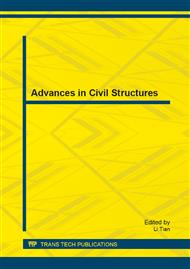[1]
Architectural Institute of Japan: Proposal 2050 Vision, Building-related Measures to Counteract Global Warming Towards Carbon-Neutralization (2009).
Google Scholar
[2]
Ministry of Agriculture, Forestry and Fisheries: Annual Report on Forest and Forestry in Japan (2011).
Google Scholar
[3]
Mamoru Iwata, Masanori Fujita: A Damage-Controlled Structure Using Buckling-Restrained Knee Braces, Structural Engineering International, International Association for Bridge and Structural Engineering, SEI Volume 21, No. 4, pp.462-470 (2011).
DOI: 10.2749/101686611x13131377725929
Google Scholar
[4]
Architectural Institute of Japan: Design Standard for Steel Structures -Based on Allowable Stress Concept- (2008).
Google Scholar
[5]
Architectural Institute of Japan: Fundamental Theory of Timber Engineering (2012).
Google Scholar
[6]
Siegfried Stiemer, Solomon Tesfamariam, Erol Karacabeyli & Marjan Propovski: Development of Steel-Wood Hybrid Systems for Buildings under Dynamic Loads, STESSA 2012, Santiago, CD6p (2012).
Google Scholar
[7]
Takeshi HORII, Hiroyasu SAKATA, Toru TAKEUCHI, Tatsuto SUZUKI, Hiroshi NAKAMURA: Experimental study on mechanical behavior of glulam timber-steel composit member using shearing connector, Journal of structural engineering (Transaction of AIJ), No. 584, pp.125-132 (2004).
DOI: 10.3130/aijs.69.125_3
Google Scholar
[8]
Masanori FUJITA, Mamoru IWATA: Reuse System of Building Steel Structures, Structure & Infrastructure Engineering, Vol. 4, No. 3, Taylor & Francis, pp.207-220 (2008).
DOI: 10.1080/15732470600720351
Google Scholar
[9]
Masanori FUJITA, Mamoru IWATA: Guideline for reusable members of building steel structures and test, International Association for Bridge and Structural Engineering, Codes in Structural Engineering Developments and Needs for International Practice, pp.545-552 (2010).
Google Scholar


